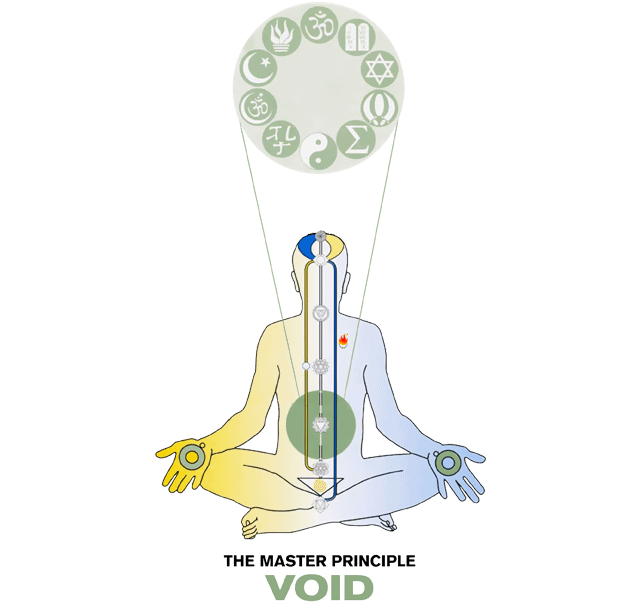The Subtle Energy centers
The Void Region (Ocean of Illusion)
Location and Essential Qualities
Location: Abdominal cavity, circular region including the stomach and abdomen. (Nabhi and Swadisthan are represented inside the Void area.)
Vibrations: Void vibrations are felt in concentric circles around the center of the palm, like a ring around the palm.
Associated Element: The Void region is aligned with the elements of sky and saltwater.
Associated Color: Green. May symbolically represent the “ocean of illusion” within us, which we must transverse to find spiritual truth.
Physiology/physical regions governed: Void’s primary physiological function (along with Nabhi and Swadisthan) is to regulate the function of abdominal organs, such as the stomach, liver, pancreas, gall bladder, intestines, and spleen.
Essential Qualities:
- self-mastery, self-directedness, (self-regulation, emotional maturity, self-control, self-discipline, self-sufficiency)
- guru/teacher abilities
- self-actualizing and self-realizing tendencies
- pure knowledge and absorption of correct teachings (avoidance of false gurus)
- righteousness
The fundamental qualities of the Void region are self-mastery and, ultimately, the “guru principle.” It is from the Void that we are granted the power to become Self masters and to ultimately evolve into gurus or teachers, who can go on to provide guidance and enlightenment to others. The Void region allows us to take charge of our thoughts, feelings and behaviors and rise to ever-greater heights of spiritual evolution. We become self-regulating, self-reliant, self-disciplined and self-sufficient. Knowledge of the ultimate — spirituality, the divine, and our place in the universe — becomes accessible to us intuitively. Over time, we develop a sort of gravitas that compels others to seek our counsel.
Character Strengths
- spirituality, including both the private, intimate relationship between an individual and the divine, as well as the range of character strengths that may result from that relationship
- judgment (critical thinking, powers of reasoning, assessment, judiciousness, prudence, discrimination and discernment
- perspective-taking (e.g., objective reasoning; proportionate, accurate appraisals)
- aspects of self-directedness, such as resourcefulness and purposefulness
- honesty (authenticity, trustworthiness reliability, dependability)
- responsibility
- self-acceptance, nurturing oneself
- self-regulation (self-control, maturity, discipline)
- love of learning — strong desire to master new skills, topics, and collections of knowledge
Personality Trait Strengths
- purposefulness, inner-directedness/self-directedness (self-determination, autonomy, reliable)
- self-transcendence, self-actualizing and self-realizing tendencies, self-forgetfulness (spiritual acceptance, strong desire to spiritually evolve, altruistic acts, helping others acquire pure knowledge and self-awareness)
- openness to experience (open-mindedness, curious)
- self-reliance (resourcefulness, self-sufficient)
- self-discipline (willpower, self-control, impulse control, organized)
- lack of worry, low neurosis/anxiety or harm avoidance tendencies (confident, self-assured, free of guilt, manages uncertainty well), inner stability — does not crack under pressure
- cooperativeness (dutifulness, responsibility)
- may serve as a guru for others, offering guidance and comfort; is a source of strength and support for others
The Void Region: Self-Mastery
Bhavasagara
It is from the Void that we are granted the power to become Self-masters and to ultimately evolve into gurus or teachers, who can go on to provide guidance and enlightenment to others. We become self-regulating, self-reliant, self-disciplined and self-sufficient.

Benefits
The name “Void” represents the ocean of illusion or unenlightened awareness (void) within us. The Void region, along with the Nabhi and Swadisthan chakras, collectively form an integrated spiritual energy group that dictates the course of our evolution — from our creation to our ultimate spiritual journey and evolution.
In our spiritual evolution, the Void region represents a vacuum or gap that we must cross to make significant spiritual progress. (You can think of it as sort of a “leg up” in the evolutionary journey.) When the Kundalini energy is first awakened during the Self-Realization process of Sahaja, it flows across the Void region, bridging the gap within the central channel in its ascent to the 7th or Sahasrara chakra. In other words, discovering spiritual truth fills the Void or gap in the central channel. This is perhaps the most significant and definitive jump in our evolution: the ability to perceive our spirit and the divine power. It is through this process that we attain the knowledge and experience of spirituality.
In filling the Void region, we transcend the state where we must rely on external knowledge and guidance. We are now capable of being our own teacher, guide and master, as well as offering guidance to others. This doesn’t mean that we now know everything there is to know; rather, it means that we’re in complete control of ourselves and intuitively know how and where to seek pure knowledge and information and humble enough to seek it. You will find that your temperament becomes more magnetic. Others will sense your depth of knowledge and gravitate to you — and come to rely on you — because “you always seem to know the right thing to do.”
The Void allows us to develop an unshakable sense of Self or Spirit, even when the people and events around us is in flux. Or character and temperament becomes more inner-directed, rather than allowing ourselves to be ruled by cultural or societal pressure, or the opinions or interference of others. We do not cling to the collective fears, beliefs, and laws of the masses. We live in accordance with our own standards and self-expectations, rather than obsessing about whether others approve of our actions. We learn to trust own judgment, experiences and personal standards, and we’re not afraid to stand up for our principles. And we accept responsibility for our own continued growth and development.
Because we have now an internal locus of control, we become self-regulating, thus, ultimately, self-determined. Self-determined people know how to capitalize on their self-knowledge. Emotional self-regulation involves self-monitoring (awareness of our actions) and accurate self-evaluation (judging the acceptableness of our actions). Self-regulation includes the key attribute of discipline. We have the ability to reign in destructive impulses, visualize the consequences, and delay immediate gratification in order to achieve our more important long-term spiritual goals.
Nourishing the Void area improves our perspective-taking skills. We can develop an enduring capacity to assimilate and examine all possible points of view, which helps us develop more evolved perspectives and make wiser choices, as well as pass that expert knowledge on to others. Perspective-taking allows us to address important questions about the meaning and purpose of life. Good perspective-taking skills are a mark of emotional maturity and self-regulation skills. We can develop proportionate, accurate perspectives of people and situations because we are better able to use objective reasoning to weigh evidence fairly, rather than jumping to conclusions or merely accepting the popular view.
Despite our guru abilities, we retain our humility. We do not attempt to enhance our own image in the eyes of others. We let our accomplishments speak for themselves and do not regard ourselves as more “special” than we are.
Symptoms Checklist
Experiencing any of these symptoms may be a sign that your Void region needs balancing…
- inability to develop self-awareness, self-control and self-discipline
- urge to follow the teachings of false gurus
- excessive use of alcohol


